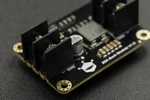










60W Adjustable DC-DC Buck Converter Module
- $9.70 3+ items
- $9.50 5+ items
- $9.20 10+ items
Introduction
What is a buck converter?
A buck converter is a DC-to-DC converter that steps down the input voltage and steps up the output current. It does not waste as much power as heat as a linear regulator does. A buck converter is made up of a switch, a diode, an inductor, and a capacitor. The switch determines how much of the input voltage reaches the inductor and capacitor. They act as filters to smooth out the output voltage and current.
Introduction of 60W Adjustable DC-DC Buck Converter Module
Still bothered by how to correctly power your RGB LED strip or get smooth servo movement? Don’t worry, this 60W DC-DC buck converter takes care of all.
This buck converter module converts high-power 12V or lithium battery 11.1V to 5V output. 60W power can be available with only one such module! Featuring adjustable 0.6V-5.1V output voltage and up to 18A output current, the module can be used to drive a 5m WS2812 RGB LED strip or other device requiring low voltage and high current.
In addition, the converter incorporates protective functions like short-circuit protection, over-current protection, and overheating protection to ensure stable performance.

Safe Operating Range
The parameters of the safe operating range are tested in typical experiment environments. It is recommended to measure the surface temperature of the buck converter to determine if the dissipation needs to be improved.
- Surface temperature < 80℃: the converter performs steadily
- Surface temperature in 80 - 90℃: dissipation improvement recommended
- Surface temperature >90℃: dissipation improvement is required since the overheat protection may be triggered at any time.
